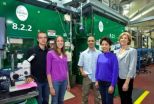Basic physical capability can predict mortality in later life
Research: Objectively measured physical capability levels and mortality: Systematic review and meta-analysis
2010-09-10
(Press-News.org) People who are better at simple physical acts such as gripping, walking, rising from a chair and balancing on one leg are more likely to live longer, according to a new study published on bmj.com today.
Measures of physical capability, such as grip strength, walking speed, chair rising time and standing balance ability, can predict mortality in older people living in the community, UK researchers found.
These measures are related to a person's ability to perform everyday tasks. There is growing interest in using such measures as simple screening tools to identify people who might benefit from targeted interventions such as strength training.
Researchers from the MRC Unit for Lifelong Health and Ageing reviewed 57 studies and found 28 that looked at physical capabilities in people of any age and recorded subsequent mortality. They excluded studies of people in institutions such as hospitals and care homes.
Most of those study authors were contacted by the research team and asked to complete a standardised results table and ultimately, after also obtaining unpublished results from five other studies, 33 sets of results were collated and included in the review.
The team found that, although there was some variation between studies, there was consistent evidence of associations between all four measures of physical capability and mortality – people who performed less well in these tests had a consistently higher risk of death.
From 14 studies (including 53,476 participants) that dealt with grip strength, the death rate among the weakest people was 1.67 times greater than among the strongest people, after taking age, sex, and body size into account.
From five studies (including 14,692 participants) that dealt with walking speed, the death rate among people who were slowest was 2.87 times greater than among the people who were fastest, after similar adjustments.
Five studies (including 28,036 people) that dealt with chair rising showed that the death rate of people who were the slowest was almost twice the rate of people who were fastest at this physical task.
Most of the studies were carried out amongst older people, but the association of grip strength with mortality was also found in younger populations.
The authors say that this review has highlighted the paucity of studies in this field in younger populations, and they also call for more research to examine the associations between changes in capability with age and mortality, as a steep decline in physical capability may be a better predictor of mortality than is the absolute level at a single point in time.
They conclude: "Objective measures of physical capability are predictors of all cause mortality in older community dwelling populations. Such measures may therefore provide useful tools for identifying older people at higher risk of death."
INFORMATION: END
ELSE PRESS RELEASES FROM THIS DATE:
2010-09-10
Diagnostic errors are the most important causes of avoidable harm to patients in hospitals, warns a senior doctor on bmj.com today.
Dr Gordon Caldwell, a consultant physician at Worthing Hospital in Western Sussex argues that doctors need better facilities and sufficient time to make a correct diagnosis.
When a patient is admitted to hospital, the team of doctors formulate a "working diagnosis," he explains. At this point, the diagnosis is uncertain but the patient is treated as if the working diagnosis is correct.
"If over the next few days the patient gets better, ...
2010-09-10
Imagine a war in which you are vastly outnumbered by an enemy that is utterly relentless – attacking you is all it does. The intro to another Terminator movie? No, just another day for microbes such as bacteria and archaea, which face a never-ending onslaught from viruses and invading strands of nucleic acid known as plasmids. To survive this onslaught, microbes deploy a variety of defense mechanisms, including an adaptive-type nucleic acid-based immune system that revolves around a genetic element known as CRISPR, which stands for Clustered Regularly Interspaced Short ...
2010-09-10
Los Angeles, CA (September 7, 2010) – Joseph Stalin once claimed that a single death was a tragedy, but a million deaths was a statistic. New research from the Kellogg School of Management at Northwestern University validates this sentiment, confirming large-scale tragedies don't connect with people emotionally in the same way smaller tragedies do.
The new study, entitled "The Scope-Severity Paradox: Why doing more harm is judged to be less harmful," has been published in the current issue of Social Psychological and Personality Science (published by SAGE) and was conducted ...
2010-09-10
CHAMPAIGN, Ill. — Vaccine manufacturers and public health decision-makers need to collaborate in a more efficient and effective manner not only to reduce the likelihood of supply shortages for pediatric vaccines but also to maximize community immunity by using vaccine doses to increase coverage, according to research published by a University of Illinois researcher who specializes in statistics and data analysis.
Sheldon H. Jacobson, a professor of computer science and the director of the simulation and optimization laboratory at Illinois, says that the Pediatric Vaccine ...
2010-09-10
CAMBRIDGE, Mass. — For the first time, a team of MIT chemical engineers has observed single ions marching through a tiny carbon-nanotube channel. Such channels could be used as extremely sensitive detectors or as part of a new water-desalination system. They could also allow scientists to study chemical reactions at the single-molecule level.
Carbon nanotubes — tiny, hollow cylinders whose walls are lattices of carbon atoms — are about 10,000 times thinner than a human hair. Since their discovery nearly 20 years ago, researchers have experimented with them as batteries, ...
2010-09-10
MADISON, WI, September 9, 2010 – Cotton growers can produce more cotton if they plant early, but not without irrigation. That's the finding of an article published in the September-October 2010 Agronomy Journal, a publication of the American Society of Agronomy.
Bill Pettigrew, a scientist with the USDA-Agricultural Research Service in Stoneville, Mississippi, tested the performance of cotton under irrigated and non-irrigated plots, with half the plots being planted early (first week of April) and half being planted in the more tradition time period, around the 1st week ...
2010-09-10
HACKENSACK, N.J. (September 9, 2010) — Researchers from the John Theurer Cancer Center at Hackensack University Medical Center played an important role in a study that led to the Food & Drug Administration's (FDA) recent fast tracking of ipilimumab, a promising treatment for metastatic melanoma. The FDA based its decision largely on the results of a pivotal study published in the New England Journal of Medicine on August 19, 2010 – the same day the agency accepted Bristol-Myers Squibb's application for the drug's approval and granted the application priority review status.
Ipilimumab ...
2010-09-10
The following highlights summarize research papers that have been recently published in Journal of Geophysical Research-Atmospheres (JGR-D) and Geophysical Research Letters (GRL).
In this release:
Landmass shape affects extent of Arctic sea ice
Estimating how much rain forests intercept
How compliant fault zones respond to nearby earthquakes
Measuring the rate of mountain building in New Zealand
Interplanetary magnetic field causes changes in the polar cap ionosphere
Oxygen and hydrogen follow different escape paths from Venus's atmosphere
Anyone ...
2010-09-10
SAN FRANCISCO, CA – September 9, 2010 – Amyloid beta (Αβ) proteins, widely thought to cause Alzheimer's disease (AD), block the transport of vital cargoes inside brain cells. Scientists at the Gladstone Institute of Neurological Disease (GIND) have discovered that reducing the level of another protein, tau, can prevent Aβ from causing such traffic jams.
Neurons in the brain are connected to many other neurons through long processes called axons. Their functions depend on the transport of diverse cargoes up and down these important pipelines. Particularly ...
2010-09-10
Researchers at the University of California, San Diego School of Medicine have identified "secondary over-triage" as a potential area of cost savings for our nation's health care. The phenomenon of over-triage occurs when patients are transferred twice, and discharged from a second facility in less than 24 hours. These findings will be published in the September 10th issue of The Journal of Trauma.
"By looking at the number of times patients are transferred, we can evaluate the overall efficiency of our trauma system and its impact on healthcare costs," said Hayley Osen, ...
LAST 30 PRESS RELEASES:
[Press-News.org] Basic physical capability can predict mortality in later life
Research: Objectively measured physical capability levels and mortality: Systematic review and meta-analysis

